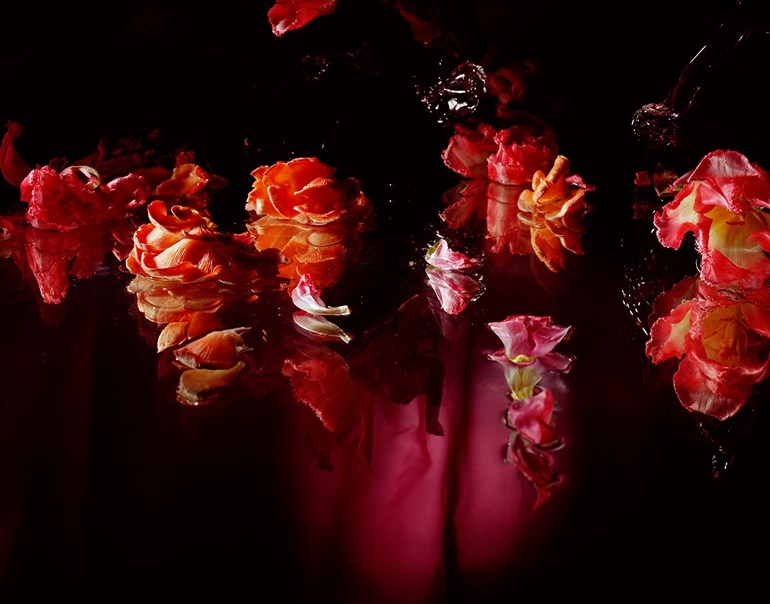Bloody Hell
O benefit of Ill
2008, Cibachrome, 125 x 182 cm and 55 x 80 cm
O Benefit of Ill
The ability of photography to match the expressive and literary qualities of painting was appreciated by its earliest practitioners. Hand-colouring and staged compositions date as far back as daguerreotypes and continued as the medium became more flexible and sophisticated. At the same time, still life always a time-honoured subject for painters was a natural for photography as it was inert and therefore lending itself to the long exposures necessary to early photographic techniques.
William Fox Talbot, one of photography’s pioneers and early masters, frequently took pictures of sculptures, everyday items and objects of nature like leaves and snowflakes. Flowers in particular have appealed to generations of photographers not only because of their beauty but also because a photograph allows details to be observed that would otherwise be impossible with the naked eye.
Unfortunately, contemporary artists and photographers enthusiasts often look askance at flower photography precisely because these are liable to be just pretty as if beauty cannot exist alongside serious and complex aesthetic considerations. In short, reverse snobbery has robbed many of us of our ability to appreciate photographs of flowers as something other than superficial and decorative.
Margriet Smulders’ flowers are certainly gorgeous but their exquisiteness is a means to an end, drawing us in long enough to convey a plethora of ideas and emotions. In O Benefit of Ill, many of the blossoms are full-blown or just past their moment of perfection which suggests the impermanence of life and health. This subject, memento mori as a reminder of death is a red thread throughout the history of art. Wormy apples, human skulls and other references to decay recur throughout Renaissance religious paintings, exhorting us to embrace Christ and Christian principles before it is too late.
Dutch still-life painters of the 17th and 18th centuries, with whose work Ms. Smulders is of course intimately familiar, were masters at representations of fruit, flowers and other aspects of the natural world. These were meant as tales of morality and mortality. However, she goes further by using colour and reflection to introduce greater visual intricacy and ambiguity on the one hand, as well as notions of reality and illusion, which are meant to convey perhaps even the concept of heaven and hell.
Smulders’ intensely coloured tulips and mushrooms in O Benefit of Ill have lost their freshness and are strewn in a space made obscure by dark shadows that blurs edges and proportions. Yet the flower petals do not float, rather they sit on something that reflects back so accurately that it is difficult to distinguish between what is tangible and what is not. This is a looking-glass world where nothing is exactly what it seems, where rather one cannot get a firm understanding of what we see. Things are insubstantial, evanescent, ungraspable, captured solely through the lens of a camera, which lacking depth are of dubious truth.
There is also something fearful and even poisonous about O Benefit of Ill. The colours are sulphuric and ghastly. The lighting is stark, even shocking. Sometimes danger lurks in the dark corners ready to pounce when we least expect it. Perhaps the Shakespearean sonnet referred to in Smulders’ title provides a hint to the significance of this aspect of the photograph:
O benefit of ill, now I find true
That better is by evil, still made better;
And ruin’d love, when it is built anew,
Grows fairer than at first, more strong.
So perhaps by their withering and in immanent demise, the ruin’d flowers captured in this photograph are emblematic of the sweet odours and loveliness that was recently theirs, making them memento vitae, a remembrance of life.
Another point worth making is that O Benefit of Ill is part of a series Smulders calls Bloody Hell, which represents the underbelly or flip side of her earlier, more romantic and flirtatious work. Her compositions have always embraced complexity and have tended to be grand, all the better to overwhelm and confuse the viewer. However, the pieces that make up Bloody Hell are more iconic and evocative than they are in telling a story. They are wonderfully horrible precisely because they suggest rather than explain their meaning. They do not hit you on the head, but rather worm their way into your subconscious.
To this extent, Smulders has proven capable of great emotional breadth even as she stays within an identifiable personal style. At times cool, hot, gorgeous, sophisticated, frightening, flippant, cerebral, or even quasi-scientific, Smulders’ work always grabs you and refuses to let go. When I first saw these photographs in a book on the desk of a gallerist friend in New York City, I felt driven to contact the artist and find out more about the person behind this extraordinary oeuvre. Since that time, I have seen a lot more work and have never once been disappointed.

